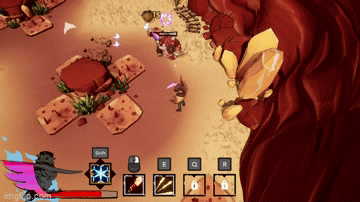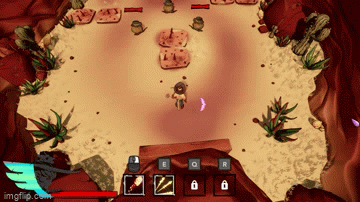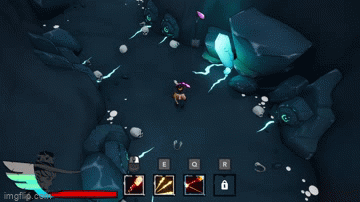Legend of the Outlaw Mage
GAME INFORMATION
Role: Level Designer
Date: September-December 2021
Team Size: 19
Genre: Action, RPG
Engine: Unreal Engine 4
LEGEND OF THE OUTLAW MAGE is a single-player, 3rd person action RPG. You play as Charlotte, an outlaw mage seeking revenge against the one who betrayed your gang. The game's fast-paced, stylish combat carries Charlotte through three levels of a larger, imagined game.
DOWNLOADS
Responsibilities
TEAM MEMBER
-
Communicated progress regularly with leads and production team, face-to-face and through JIRA
-
Worked rapidly and efficiently to complete levels within the project deadline
-
Observed outside testers to collect playtest data, then translated test data into specific items for iteration
LEVEL DESIGN
-
Took two levels from paper concept to first art pass
-
Designed, tested, and polished combat in 25 non-boss arenas across both levels
-
Implemented tutorials for combat hazards (spike traps and ranged turrets)
-
Painted landscape and placed props for a first art pass
Click each image for details and a larger view.
OUTLAW MAGE - GALLERY

DESIGN HIGHLIGHTS
Arena Design & Combat Flow
Designing Outlaw Mage's arena-like rooms did not stop with sketching and implementing their major geometry. As a level designer, I also finessed the player's movement through those spaces, using gameplay features to craft flow.
-
Enemy placement allowed me to guide players through the space naturally as they sought out mobs to defeat.
-
Hazards deter inexperienced players from taking certain paths -- or attract skilled players, who kite enemies across them or dash past, creating different movement patterns for different skill levels.
-
Props like large rocks shaped the physical space available to players, as well as provided cover.
EXAMPLE: The arena in the image uses hazards to create paths for the players. Mob spawn placement then added another layer of design, guiding the player around those paths to flow around the space.

A combination of enemy placement and hazard placement allowed me to create a looping flow of player movement in the arenas, making use of the entire space during combat.
Teaching Mechanics

Because of how I placed the Grunt enemies in this room, at least one would immediately move forward to die on the spikes, demonstrating the kiting mechanic for the player.
Designing the first and second levels of the game meant introducing several new mechanics, such as spike traps and ranged turrets. I followed the same steps for each:
-
Demonstrate the mechanic
-
Set the player up to use the mechanic
-
Challenge/complicate the mechanic
EXAMPLE: On entering the room shown here, the player sees several grunt mobs rush forward... only to impale themselves on spikes. This demonstrated the mechanic of kiting enemies across dangerous ground.
After seeing this, the player has the opportunity to use the spikes intentionally as more grunts spawned before moving on to more challenging rooms.
Worldbuilding
When tutorials and mechanics were polished, I moved on from the major geometry of each space to first- and second-pass aesthetics. As a level designer, I ensured the aesthetics I implemented worked to augment the gameplay. Lights, props, and more doubled as conveyance for the player, either guiding them along the path or warning them about hazards to come.
EXAMPLE: One of the hazards, the crushing rocks, were designed to match the stone of the cave wall when retracted. However, playtest feedback showed people had a hard time spotting their location at a glance.
To address this, I placed glowing floor decals along the line drawn by the crushers. Testers then reported that the subtle light helped draw their eye to where the hazards would be, helping them significantly in locating the threat.

The glowing blue decals just under the crushers' paths were a subtle addition, but made a huge difference in playtesters noticing the hazard and learning to avoid them.
POSTMORTEM
What Went Well
-
Onboarding. I joined Outlaw Mage several months into development, after the game look and design had been finalized. After reviewing design documentation and sharing questions with the leads, I was fully onboarded with the team by the end of the week, allowing me to jump right into contributing to the game.
-
Iteration speed. Throughout development, the team prioritized flexible tools and "finding the fun", getting ideas on screen quickly to test their quality. This allowed me to do a lot of my own QA testing over many iterations, ensuring the work I was submitting was always polished.
What Was Learned
-
Flow can make or break a level. Playtesters reported much higher levels of fun when testing arenas with smooth, forward-oriented flow, despite the gameplay being fundamentally the same.
-
Constant, collaborative testing makes the game shine. All throughout development, the level design team passed their work back and forth for testing, taking notes and recording videos for each other so that we could ensure our game was the best it could be. Though each of us had ownership over discrete areas of the game, testing all aspects both gave us a better sense of how our pieces fit into a bigger picture and how to improve our own work.




